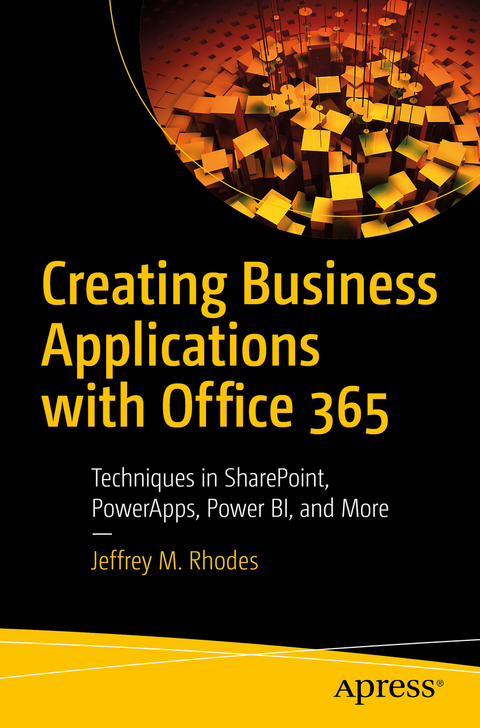
Creating Business Applications with Office 365
Apress (Verlag)
978-1-4842-5330-4 (ISBN)
- Titel erscheint in neuer Auflage
- Artikel merken
Take your Office 365 and SharePoint projects to a higher level by using PowerApps, Flow, Power BI, JavaScript/jQuery jQuery UI widgets, Cascading Style Sheets (CSS), and more. This book will help you create easier solutions to client-side problems and applications. Additionally, you will be able to effectively visualize your data with Power BI.
This book starts with configuration of SharePoint and Office 365 followed by your first example of PowerApps. You will lay the foundation for a help ticket application and see how to update a SharePoint list with PowerApps. You then will work with the jQuery open source library and learn how to use the developer tools within your browser. This allows you to customize data displays in SharePoint.
Next, you will add jQuery UI widgets such as buttons and dialogs to SharePoint, learning how to configure and manipulate them via JavaScript. You will use these new skills to convert a normal SharePoint announcement into a visually compelling page of network alerts. You also will use JavaScript and styles to hugely improve native SharePoint calendars by color-coding them by category or location. To prevent overlapping events in calendars, you will work with SharePoint's web services and JavaScript. You will use similar concepts to make appealing accordion SharePoint pages.
You then will explore Microsoft Forms, Flow, and Power BI, including building surveys in both Forms and SharePoint and using Power BI to show results over the last week, month, quarter, and year. Using advanced Power BI you will see how to deal with JSON, XML, and Yes/No data. Next, you will look at how to display Office documents as well as interact with them via JavaScript.
Switching back to PowerApps, you will build the final help ticketing system before using Power BI to see how to visualize the ticket information. After a quick detour on using iFrames in SharePoint, you will jump into building a power routing application using InfoPath and SharePoint Designer. You will even call SharePoint’s web services from Designer to customize email notifications. You end the InfoPath set of chapters with a highly useful application for signing up for and managing attendance for training and other classes. Finally, you will add Google Analytics to track SharePoint usage.
What You Will Learn
Build powerful applications with PowerApps
Extend SharePoint’s capabilities using JavaScript
Create surveys with SharePoint and Microsoft Forms, copy the results to SharePoint using Flow, and visualize the data with Power BI
Employ advanced Power BI techniques to include custom columns, pivoting, and dealing with JSON, XML, and Yes/No data
Use InfoPath and SharePoint workflows to create routing systems, schedule classes, and other advanced tasks
Who This Book Is For
Business and application developers
Jeffrey Rhodes is the Academic Chief Technical Officer at the United States Air Force Academy. Prior to that, he was Senior IT Specialist in charge of SharePoint, Remedy, and other key systems at the Academy. Jeff was the founder and Chief Technical Officer of Platte Canyon Multimedia Software Corporation, a leader in developing commercial e-learning software. He graduated at the top of his class at the Air Force Academy, where he earned a bachelor's degree in electrical engineering. Jeff received a master’s degree in economics from the London School of Economics, which he attended under a British Marshall Scholarship. He is the author of Programming for e-Learning Developers: ToolBook, Flash, JavaScript, and Silverlight, VBTrain.Net: Creating Computer and Web Based Training with Visual Basic .NET and The ToolBook Companion. He lives in Colorado Springs with his wife Sue and is the proud father of his sons Derek and Michael.
Chapter 1: Enabling SharePoint Designer & Custom Scripting
Chapter Goal: This chapter will explain how to configure SharePoint and Office 365 to allow many of the solutions in this book. Specifically, it shows how to allow the Content Editor web part and the use of SharePoint Designer.
No of pages: 6
Chapter 2: Customizing Date Displays with jQuery
Chapter Goal: This chapter will introduce the jQuery library and then launch into our first solution. We inject jQuery into the page in order to customize the color of the “Due Date” column in a SharePoint Task List so that it is amber when we are within 30 days of that date and red when we are within seven days. We also look at how to use the Developer Tools within your browser to help in the design of the solution as well as in debugging it.
No of pages: 6
Chapter 3: Adding jQuery UI Controls
Chapter Goal: This chapter will introduce the jQuery UI set of widgets. It will cover the styling as well as the JavaScript to configure and use them effectively. The examples demonstrate both the button and dialog controls.
No of pages: 5
Chapter 4: Customizing an Announcement List with jQuery
Chapter Goal: This chapter will demonstrate how to convert a normal SharePoint announcement list into a visually-compelling page of “network alerts” that display with styles (colors, font size, etc.) based on the category of information. We dig into the browser’s Developer Tools to figure out the design and help in debugging.
No of pages: 9
Chapter 5: Creating a Color Calendar
Chapter Goal: This chapter will demonstrate how to use JavaScript and styles to color-code SharePoint calendar events by location or another category. While we are at it, we will show a “key” of what each color represents.
No of pages: 6
Chapter 6: Preventing Double-Booking of Calendar Events
Chapter Goal: This chapter will dig deep into calling SharePoint’s web services from JavaScript in order to prevent double-booked (overlapping) calendar events. The solution shows how to insert the logic into the New and Edit dialog boxes, override the Save event, debug via the browser’s Developer Tools, and more.
No of pages: 12
Chapter 7: Building an Accordion Interface
Chapter Goal: This chapter will show how to use JavaScript/jQuery to create an efficient and user-friendly “accordion” interface in SharePoint. Each heading shows or hides document libraries, lists, images, or other content up until the next heading.
No of pages: 10
Chapter 8: Creating an Approval Process with Microsoft Flow
Chapter Goal: This chapter will demonstrate how to use SharePoint, Flow, and Outlook for an approval process. We first create an “Equipment Request” SharePoint list. When the user fills out a request, Flow generates an approval email to the manager, who can then approve the request from within Outlook.
No of pages: 7
Chapter 9: Creating a Survey Response Dashboard with Microsoft Power BI
Chapter Goal: This chapter will show how to create a survey in SharePoint and then greatly enhance its visualization using Power BI. In particular, we will use Power BI to create a Days Passed column that we will use to restrict results to the previous week, month, quarter, and year.
No of pages: 7
Chapter 10: Creating a Survey Solution with Microsoft Forms, Flow, SharePoint, and Power BI
Chapter Goal: This chapter will use Microsoft Forms as the survey engine instead. It will then show how to use Flow to copy each survey result to a SharePoint list, which will in turn serve as the data source for Power BI.
No of pages: 5
Chapter 11: Power BI Challenges with JSON, XML, Yes/No, and Other Data
Chapter Goal: This chapter will go deeper into Power BI to explore how to effectively handle data that is formatted as JavaScript Object Notation (JSON) or Extensible Markup Language (XML). It will also demonstrate how to pivot and use other techniques to display Yes/No and other data types.
No of pages: 9
Chapter 12: Power BI Case Study: Monitoring BMC Remedy Help Tickets
Chapter Goal: This chapter will show how to connect Power BI directly to a SQL Server database. It will show how to handle such challenges as a Unix date format as well as how to join tables within Power BI.
No of pages: 10
Chapter 13: Displaying and Working with Office Documents
Chapter Goal: This chapter will first show how to embed Word, Excel, PowerPoint, and similar types within SharePoint pages. It will then show you how to embed the types in edit mode, which is very helpful for allowing multiple users to edit a single document or workbook. Finally, it shows how to interact with the Excel web part with JavaScript so that we can match the named area displayed to the current date.
No of pages: 6
Chapter 14: Creating a Routing System Using InfoPath and Designer Workflows
Chapter Goal: This chapter shows how to create a routing system using SharePoint, InfoPath, and SharePoint Designer workflows. The user selects an “approval” chain. The system then routes the form to each person in turn, sending email notifications both to the next person in line as well as to the user (when the form is approved).
No of pages: 13
Chapter 15: Using SharePoint REST Services to Control Email Notifications
Chapter Goal: This chapter will demonstrate an advanced SharePoint Designer workflow technique of using SharePoint’s Representational State Transfer (REST) API to read a SharePoint list and use that to send emails to anyone in that list who has a “send email” column set to true.
No of pages: 14
Chapter 16: Creating a Class Sign-Up Solution in SharePoint
Chapter Goal: This chapter will demonstrate a technique of using a Training Class SharePoint list, linked to an Attendee list, and then customized with some heavy-duty InfoPath data connections to look up whether the class has empty slots and, if so, allow the student to register. The solution allows the student to delete his or her registration later, freeing up a slot.
No of pages: 8
Chapter 17: Adding Google Analytics
Chapter Goal: This chapter will show how to add Google Analytics to one or more SharePoint pages. It will look at how to track user locations and even what links users selected.
No of pages: 9
| Erscheinungsdatum | 21.11.2019 |
|---|---|
| Zusatzinfo | 1 Illustrations, color; 185 Illustrations, black and white; XVIII, 241 p. 186 illus., 1 illus. in color. |
| Verlagsort | Berkley |
| Sprache | englisch |
| Maße | 155 x 235 mm |
| Gewicht | 454 g |
| Themenwelt | Mathematik / Informatik ► Informatik ► Netzwerke |
| Mathematik / Informatik ► Informatik ► Programmiersprachen / -werkzeuge | |
| Mathematik / Informatik ► Informatik ► Software Entwicklung | |
| Informatik ► Theorie / Studium ► Compilerbau | |
| Schlagworte | JavaScript • jQuery • Microsoft Flow • Microsoft Forms • Office 365 • Power BI • SharePoint |
| ISBN-10 | 1-4842-5330-2 / 1484253302 |
| ISBN-13 | 978-1-4842-5330-4 / 9781484253304 |
| Zustand | Neuware |
| Informationen gemäß Produktsicherheitsverordnung (GPSR) | |
| Haben Sie eine Frage zum Produkt? |
aus dem Bereich



